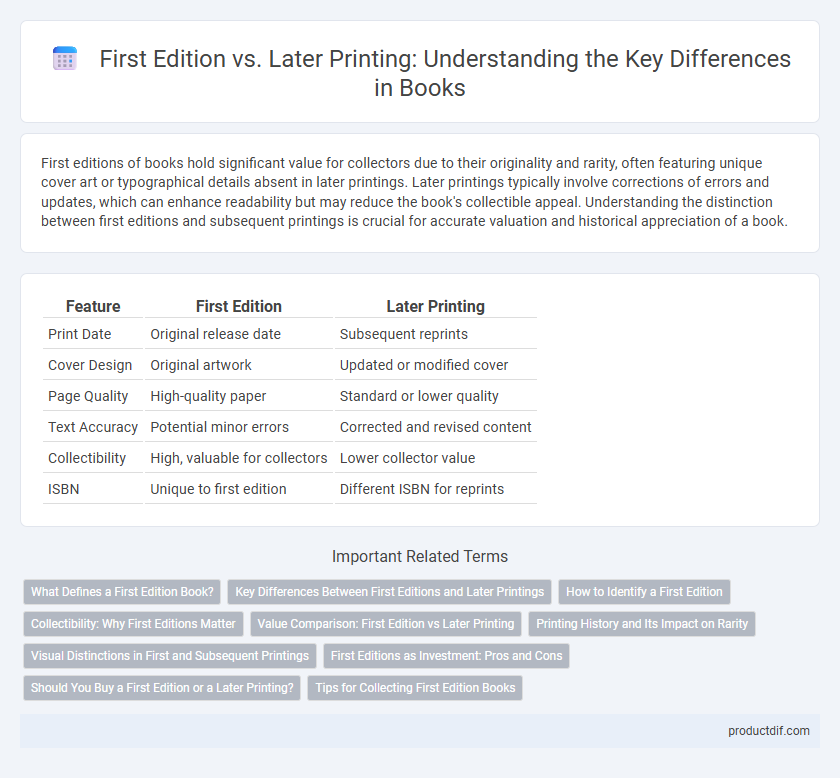First editions of books hold significant value for collectors due to their originality and rarity, often featuring unique cover art or typographical details absent in later printings. Later printings typically involve corrections of errors and updates, which can enhance readability but may reduce the book's collectible appeal. Understanding the distinction between first editions and subsequent printings is crucial for accurate valuation and historical appreciation of a book.
Table of Comparison
| Feature | First Edition | Later Printing |
|---|---|---|
| Print Date | Original release date | Subsequent reprints |
| Cover Design | Original artwork | Updated or modified cover |
| Page Quality | High-quality paper | Standard or lower quality |
| Text Accuracy | Potential minor errors | Corrected and revised content |
| Collectibility | High, valuable for collectors | Lower collector value |
| ISBN | Unique to first edition | Different ISBN for reprints |
What Defines a First Edition Book?
A first edition book refers to the initial run of copies produced and released by the publisher when a work is first published, often characterized by unique printing details and original dust jackets. Collectors value first editions for their rarity, original content, and sometimes subtle variations in text or illustrations compared to later printings. Later printings, or subsequent editions, typically include corrections or changes and are distinguished by printing numbers or states noted in the book's colophon or copyright page.
Key Differences Between First Editions and Later Printings
First editions are the initial print runs, often valued for their originality and potential rarity, while later printings typically include corrections, updates, or design changes. Collectors prioritize first editions due to unique printing errors or limited quantities that may not be present in subsequent printings. Identifying features such as publisher's marks, ISBN changes, and altered dust jacket designs help distinguish first editions from later printings.
How to Identify a First Edition
Identifying a first edition involves examining the book's copyright page for specific markings, such as the phrase "First Edition" or a number line starting with "1." Collectors also check for original dust jackets, unique printing errors, or publication dates that differentiate the first edition from later printings. Consulting publisher records and bibliographies can provide authoritative confirmation of a book's first edition status.
Collectibility: Why First Editions Matter
First editions hold higher collectibility due to their rarity and originality, often featuring unique cover art, typesetting, or author signatures not present in later printings. Collectors value first editions as they represent the book's initial release and historical significance, frequently commanding premium prices in the rare book market. Later printings, while more common and accessible, typically lack the distinctive attributes and provenance that make first editions highly sought after by bibliophiles.
Value Comparison: First Edition vs Later Printing
First edition books generally hold significantly higher value than later printings due to their rarity and original publication status, making them highly sought after by collectors and investors. Later printings, while often more abundant and affordable, typically lack the unique identifiers such as first edition marks, limited print runs, or original dust jackets that contribute to the premium price of first editions. Market demand, condition, and historical significance further influence the collectible value disparity between first editions and subsequent printings.
Printing History and Its Impact on Rarity
First editions often hold greater value due to their limited print runs and original binding materials, marking the initial release of a book. Later printings, while easier to find, may include corrected errors or updated content but typically lack the scarcity that defines first editions. Printing history significantly impacts a book's rarity and market demand, with first editions serving as key artifacts for collectors and historians.
Visual Distinctions in First and Subsequent Printings
First edition books often feature unique cover designs, distinct typography, or specific dust jacket artwork that differ subtly from later printings. Collectors identify first editions by details such as publication date, printer's marks, or slight variations in binding materials. Subsequent printings typically include updated copyright pages and may simplify or alter visual elements to reduce production costs.
First Editions as Investment: Pros and Cons
First edition books often hold significant investment value due to their rarity, unique cover art, and potential for appreciable market demand. However, factors such as condition, limited print runs, and specific author notoriety heavily influence their long-term worth. Later printings may lack first editions' investment appeal but offer greater accessibility and affordability for casual collectors.
Should You Buy a First Edition or a Later Printing?
First editions often hold higher collectible value due to their originality and limited print runs, attracting serious collectors and investors. Later printings typically offer affordability and improved readability, sometimes incorporating corrections or updates not present in the first edition. Making a decision between a first edition and a later printing depends on whether the priority is investment potential or accessibility for reading.
Tips for Collecting First Edition Books
Collectors often prioritize first edition books because of their rarity and higher market value compared to later printings. Key tips include verifying the publisher's imprint, checking for specific points of issue such as typos or design details unique to the first print run, and examining the dust jacket condition, which significantly impacts collectibility. Utilizing bibliographic references and consulting specialized collectors' guides enhances accuracy in identifying authentic first editions.
First Edition vs Later Printing Infographic

 productdif.com
productdif.com